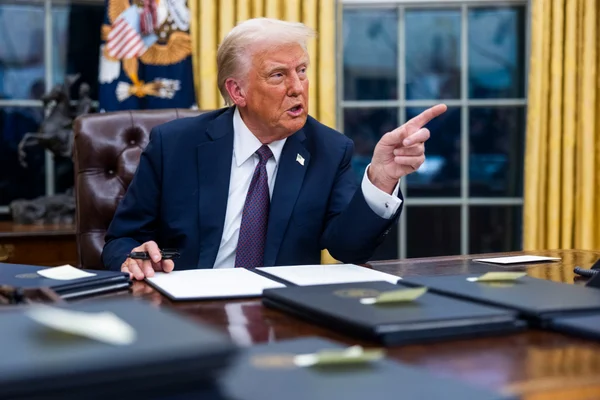When Trump Executive Orders assumed office in January 2017, he immediately turned to executive orders to advance his agenda. Trump’s use of executive orders was extensive, targeting immigration reform, healthcare changes, national security, and environmental policies. These orders had a lasting impact on the political landscape of the United States, influencing policy decisions well beyond his presidency.
In this blog post, we’ll explore 10 of the most significant Trump executive orders that made waves in U.S. governance, examining their broader implications on both domestic and global issues.
What Are Trump Executive Orders?
Trump executive orders are direct orders issued by the president of the United States that govern federal agencies and policy. These orders hold the force of law and do not require the approval of Congress, although they can be challenged in court. Executive orders are a common tool used by presidents to carry out their agendas and bypass legislative gridlock.
Throughout Trump’s time in office, he used executive orders to enact sweeping changes across a range of areas, from immigration and trade to healthcare and national security. Some of these orders sparked legal challenges, while others dramatically altered the trajectory of American policy.
1. Trump Executive Orders on Immigration Reform
Immigration reform was one of the earliest and most controversial areas where Trump relied heavily on executive orders. His administration’s efforts focused on reducing immigration, strengthening border security, and limiting refugee admissions.
Travel Ban (Executive Order 13769)
One of the most controversial Trump executive orders, signed in January 2017, was the Travel Ban, also known as the “Muslim Ban.” This executive order temporarily prohibited nationals from seven Muslim-majority countries from entering the U.S. These countries—Iran, Iraq, Syria, Libya, Somalia, Sudan, and Yemen—were targeted due to concerns about terrorism and national security.
The order was immediately met with backlash and sparked a legal battle, as critics argued that it was discriminatory and unconstitutional. Several courts blocked the order, but after modifications were made, the U.S. Supreme Court upheld a revised version in 2018. Despite legal challenges, the policy marked a significant shift in U.S. immigration policy and strained international relations.
DACA and Immigration Enforcement (Executive Order 13768)
Another key Trump executive order related to immigration was aimed at ramping up the enforcement of immigration laws and dismantling President Obama’s Deferred Action for Childhood Arrivals (DACA) program. Executive Order 13768, signed in January 2017, instructed the Department of Homeland Security (DHS) to focus on deporting undocumented immigrants with criminal records.
Trump’s decision to phase out DACA, which protected undocumented immigrants who came to the U.S. as children, generated significant debate. Although the program’s future remained uncertain due to court rulings, this executive order reflected Trump’s hardline stance on immigration and his commitment to reducing illegal immigration.
2. Trump Executive Orders on Trade and Economic Policy
Trade was another area where Trump relied heavily on executive orders to reshape U.S. policy. His “America First” approach sought to address perceived imbalances in trade and protect American industries, particularly manufacturing.
Withdrawal from the Trans-Pacific Partnership (Executive Order 13767)
One of Trump’s first actions after taking office was to withdraw the United States from the Trans-Pacific Partnership (TPP), a free trade agreement negotiated by the Obama administration. Trump’s decision to sign Executive Order 13767 in January 2017 was driven by the belief that the TPP would harm U.S. workers, particularly in the manufacturing and agricultural sectors.
The withdrawal from the TPP marked a stark shift away from multilateral trade agreements toward a more unilateral approach. Trump favored renegotiating trade deals on a bilateral basis, believing this would better serve U.S. interests.
Trade Tariffs on China (Executive Order 13873)
Another significant Trump executive order focused on the economic relationship between the United States and China. In March 2018, Trump signed Executive Order 13873, which authorized tariffs on Chinese goods as part of a broader strategy to combat intellectual property theft and unfair trade practices.
Trump’s decision to impose tariffs led to an escalating trade war between the U.S. and China, with both countries levying tariffs on each other’s goods. The trade war had far-reaching consequences for businesses, consumers, and global supply chains, ultimately prompting negotiations that resulted in a partial trade agreement in early 2020.
3. Trump Executive Orders on Healthcare Reform
Trump’s presidency also saw significant efforts to dismantle the Affordable Care Act (ACA) and alter the healthcare landscape. Executive orders were a critical tool in these attempts to modify or repeal parts of the ACA.
Repealing the ACA Mandate (Executive Order 13813)
One of Trump’s signature healthcare-related executive orders came in October 2017, when he signed Executive Order 13813 to roll back parts of the ACA. The order focused on reducing the financial burden on American families by eliminating the ACA’s individual mandate, which required individuals to have health insurance or face a tax penalty.
This executive order was celebrated by conservative groups who believed the mandate was an overreach by the federal government. However, opponents argued that repealing the mandate would lead to higher premiums and destabilize the healthcare market.
Expanding Short-Term Health Plans (Executive Order 13890)
In 2018, Trump signed Executive Order 13890, which expanded access to short-term health plans. These plans were designed to provide consumers with a more affordable, yet limited, option compared to traditional ACA-compliant health insurance plans. The order sought to provide more flexibility for consumers, particularly those who did not qualify for subsidies or were unable to afford ACA coverage.
However, critics warned that these short-term plans could leave individuals without adequate coverage for serious medical conditions. They argued that the plans would undermine the ACA’s efforts to ensure comprehensive healthcare for all Americans.

4. Trump Executive Orders on National Security and Terrorism
National security was a central focus of many Trump executive orders, particularly those aimed at combating terrorism and enhancing border security.
Executive Order on Protecting the Nation from Foreign Terrorist Entry (Executive Order 13769)
In addition to the Travel Ban, Trump’s administration issued several executive orders targeting national security threats. Executive Order 13769, signed in January 2017, aimed to improve the vetting process for individuals seeking to enter the United States, particularly from regions with high levels of terrorism.
The executive order required increased security checks for refugees and visa applicants, and it prioritized national security concerns over the processing of immigration applications. The order was part of Trump’s broader agenda to safeguard the country from foreign terrorist threats, although critics argued it unfairly targeted Muslims.
Border Wall Funding and Security (Executive Order 13767)
One of Trump’s most widely discussed executive orders was the directive to begin building a border wall along the U.S.-Mexico border. Executive Order 13767, signed on January 25, 2017, aimed to enhance border security and reduce illegal immigration by constructing a physical barrier along the southern border.
This order was emblematic of Trump’s hardline stance on immigration and his 2016 campaign promise to build a wall. While the funding for the wall was a contentious issue in Congress, Trump used executive orders to start the process and allocate resources for border security enhancements.
5. Trump Executive Orders on Environmental Policies
Trump’s environmental policies were one of the most controversial aspects of his presidency, with his administration taking a decidedly anti-regulation stance. Many of his executive orders were aimed at rolling back regulations put in place by the Obama administration.
The Paris Climate Agreement (Executive Order 13783)
One of Trump’s most high-profile environmental-related executive orders was his decision to withdraw the United States from the Paris Climate Agreement, an international treaty signed in 2015 by nearly 200 countries. Executive Order 13783, signed in March 2017, set in motion the U.S. withdrawal, with Trump arguing that the agreement disadvantaged the American economy and imposed unfair costs on U.S. businesses.
While the move was met with international condemnation, Trump justified it as a necessary step to prioritize American jobs and energy independence. The decision effectively removed the U.S. from the global effort to combat climate change, and it sparked debates about the future of international environmental diplomacy.
Reversing the Clean Power Plan (Executive Order 13783)
In addition to withdrawing from the Paris Climate Agreement, Trump issued another executive order aimed at rolling back the Clean Power Plan, an Obama-era policy designed to curb carbon emissions from power plants. Executive Order 13783 sought to reduce regulatory burdens on the fossil fuel industry and promote energy production from coal, oil, and natural gas.
This order was celebrated by the energy industry, but environmentalists warned that it would lead to increased pollution and hinder efforts to reduce the U.S.’s carbon footprint.
6. Trump Executive Orders on Criminal Justice Reform
Trump also made strides in criminal justice reform through his executive orders, working to address issues such as mass incarceration and prison conditions.
The First Step Act (Executive Order 13853)
One of the most significant pieces of criminal justice reform during Trump’s presidency was the passage of the First Step Act, signed into law in December 2018. This law aimed to reform the U.S. prison system by reducing mandatory minimum sentences for certain nonviolent offenses and expanding opportunities for rehabilitation.
The First Step Act was a rare instance of bipartisan cooperation, with both Democrats and Republicans supporting the legislation. Trump’s signing of the law reflected his administration’s willingness to address criminal justice issues, despite his more controversial policies in other areas.
Conclusion
Trump’s executive orders were a defining feature of his presidency, shaping U.S. policies on a wide range of issues, from immigration to trade, healthcare, national security, and criminal justice reform. These orders were often met with legal challenges, but many had lasting effects on American society and governance.
The legacy of Trump’s executive orders will continue to influence political debates in the years to come. Whether they were aimed at dismantling previous administrations’ policies or reshaping U.S. relationships with the world, these executive actions were central to Trump’s “America First” agenda and have had lasting consequences on U.S. policy.
